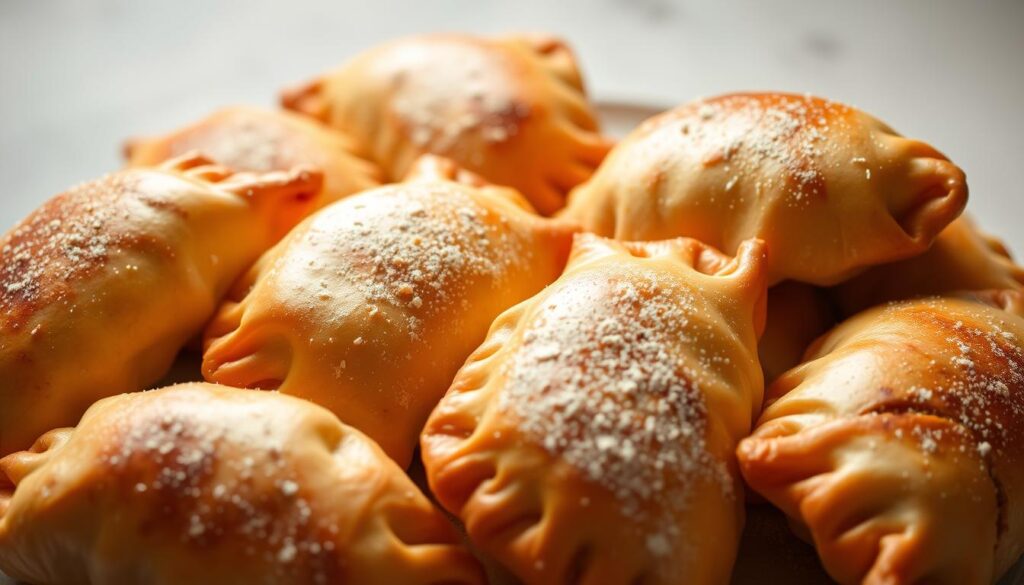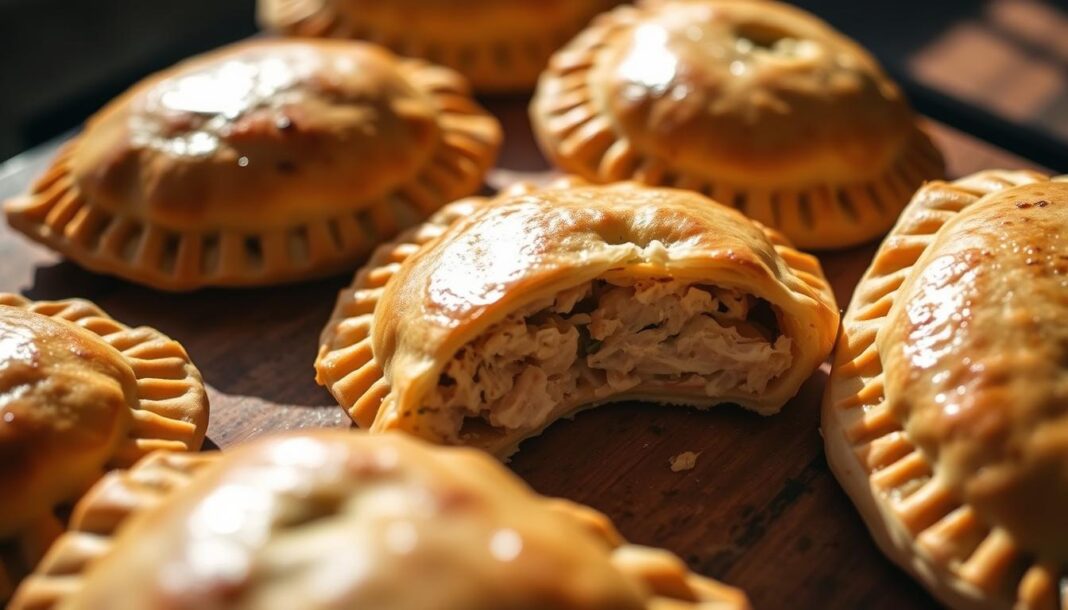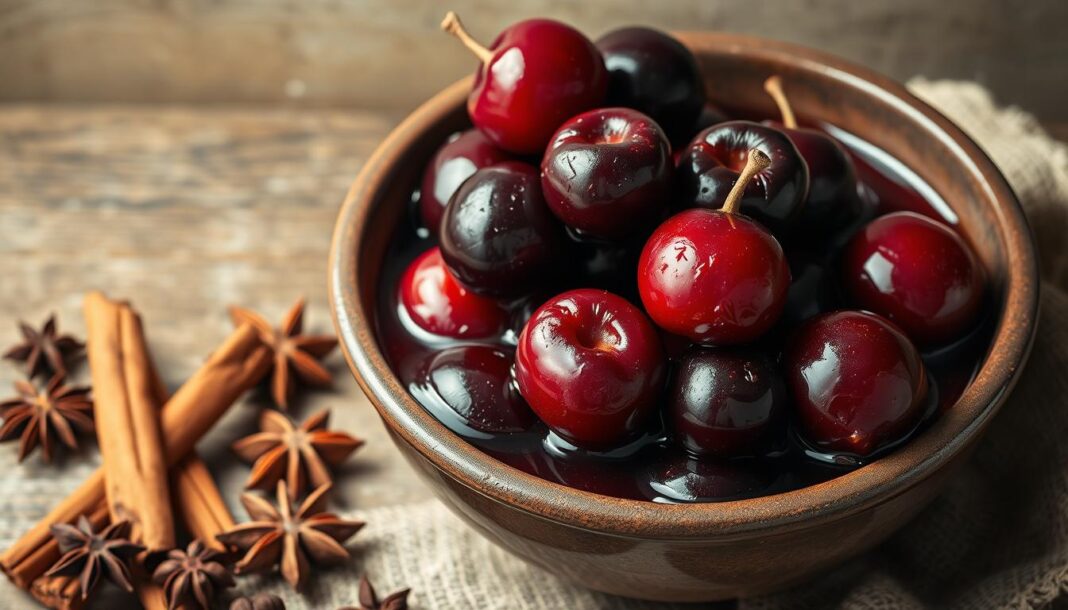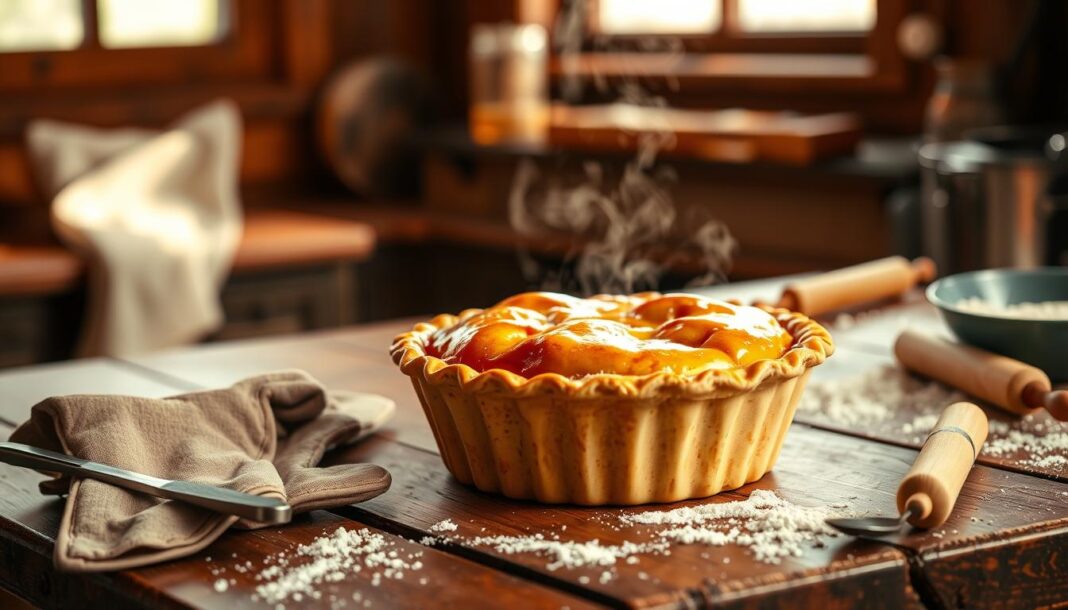Creating the perfect chicken hand pies requires a delicate balance between a flaky crust and a savory filling. These portable versions of the classic chicken pot pie are ideal for various occasions, from appetizers to packed lunches. Our expert techniques guide you through making these delicious treats from scratch, ensuring perfect results every time.
Understanding the core elements of a great pie is essential – from the preparation of the dough to achieving the right filling consistency. By mastering these fundamental techniques, you can customize your pies with different fillings while maintaining the core principles that ensure success. For inspiration on creative fillings, you might enjoy exploring our recipe for creative pie variations.
Key Takeaways
- Master the balance between crust and filling for perfect hand pies.
- Learn professional techniques for creating flaky, golden crusts.
- Understand how to achieve the ideal filling consistency.
- Discover how to customize your pies with various fillings.
- Follow our tested recipe for guaranteed success.
The Art of Homemade Chicken Hand Pies
Homemade chicken hand pies are a delightful treat that combines the comfort of a classic chicken pot pie with the convenience of a handheld snack. These individual pies are perfect for meals on the go, offering a satisfying blend of flavors and textures.

What Makes a Perfect Chicken Hand Pie
A perfect chicken hand pie achieves a delicate balance between a flaky, golden crust and a rich, flavorful filling. To accomplish this, it’s crucial to focus on the critical components that distinguish exceptional hand pies, including:
- Proper dough consistency
- Filling-to-crust ratio
- Seasoning techniques
Understanding these elements helps in creating hand pies that are both delicious and structurally sound.
Benefits of Making Hand Pies vs. Traditional Pot Pies
Hand pies offer several advantages over traditional pot pies, including:
- Portability
- Portion control
- The ability to customize individual servings
- A higher crust-to-filling ratio, which is ideal for those who enjoy the flaky pastry as much as the filling
The enclosed format of hand pies also creates a perfect steam environment that infuses the filling with flavor while maintaining moisture. Moreover, hand pies can be made ahead and frozen, offering a convenience that traditional pot pies can’t match.
Essential Ingredients for Flavorful Chicken Hand Pies
Crafting the perfect chicken hand pie begins with understanding the essential ingredients that make up both the pastry and the filling. The quality of these components directly impacts the final product’s flavor and texture.
The Perfect Pastry Options
When it comes to the pastry crust for your chicken hand pies, you have several options, including traditional pie crust and puff pastry. The choice of pastry affects the texture and flavor of your pies. For a flaky crust, a high-fat content is crucial, typically achieved with generous amounts of butter.
Traditional pie crust is a popular choice for chicken hand pies due to its balance of tenderness and structure. It’s made with flour, butter, and a touch of salt. Puff pastry, on the other hand, offers a lighter, more layered texture, ideal for those seeking a less dense crust.
Creating a Delicious Filling
The filling is where the heart of the chicken hand pie lies, and it’s a delicate balance of chicken, vegetables, and sauce. Using chicken breast, diced onion, carrot, and celery, along with potatoes, creates a satisfying texture. The ratio of these ingredients is crucial to avoid a filling that’s too soggy or too dry.
- Use a combination of chicken and aromatic vegetables for depth of flavor.
- Incorporate starchy components like potatoes for texture.
- Balance the liquid content to achieve the perfect consistency.
Herbs and Seasonings That Elevate Your Pies
Herbs and seasonings play a vital role in elevating your chicken hand pies from good to exceptional. Fresh thyme adds a subtle, earthy note, while a touch of garlic enhances the overall flavor profile. Don’t forget the importance of salt in bringing out the flavors of the other ingredients.
By carefully selecting and balancing these essential ingredients, you’ll be well on your way to creating chicken hand pies that are both flavorful and satisfying.
Mastering the Chicken Hand Pie Filling
Crafting the ideal filling is essential for making exceptional chicken hand pies. The filling is where flavors meld together, and the quality of its preparation directly impacts the overall taste and texture of the pie. We emphasize the importance of attention to detail in preparing the filling to achieve the perfect balance of flavors and consistency.
Preparing and Cooking the Chicken
To start, cooking the chicken specifically for your pies allows for better control over seasoning and moisture content. We recommend gently cooking the chicken in butter until it’s cooked through, then setting it aside. This method ensures tender, flavorful chicken that enhances the overall filling. Heat half a tablespoon of butter in a large skillet over medium-high heat, add the chicken, and season with sea salt and freshly cracked pepper. Cook, stirring often, for 3-4 minutes or until cooked through.
Vegetable Preparation Techniques
Uniform vegetable preparation is crucial for even cooking and to prevent large chunks from tearing the pastry during assembly. We suggest dicing vegetables into small, uniform pieces. In the same skillet used for the chicken, add the remaining butter, onion, carrot, celery, and thyme leaves. Season with sea salt and freshly cracked pepper, and cook until the vegetables are softened.
Creating the Perfect Sauce Consistency
The sauce is a critical component of the filling, and achieving the right consistency is key. Start by making a roux with butter and flour, cooking it until the raw flour taste disappears. Then, slowly add chicken broth and milk, whisking constantly until the sauce thickens. The ideal sauce should coat the back of a spoon but still flow slowly.
Why Cooling Your Filling Matters
Cooling the filling completely before assembling the pies is crucial. A warm filling can melt the fat in the pastry, preventing proper lamination and resulting in soggy pies. We recommend refrigerating the filling for at least 30 minutes to allow flavors to meld and the sauce to set, ensuring a filling that holds together well when the pies are cut.
Step-by-Step Chicken Hand Pies Assembly Techniques
Assembling chicken hand pies requires precision and patience, but with our guide, you’ll achieve perfect results every time. The key to successful assembly lies in preparing your ingredients and tools in advance. Start by preheating your oven to 375 degrees and lining a baking sheet with parchment paper.
Rolling and Cutting the Dough
Roll out both of your pie crusts on a lightly floured surface to the optimal thickness. If the dough is too thin, it will tear; too thick, and it won’t cook through properly. Use a 4-inch biscuit or cookie cutter to create uniform rounds. You’ll need to re-roll the dough to use it all up, aiming for around 24 rounds.
Filling and Sealing Methods
Place a spoonful of your cooled and thickened chicken mixture in the center of half of the rounds. Top each round with another pie round and press the edges together firmly to seal. Make sure to leave a small border around the filling to prevent leakage during baking.
Crimping and Decorating Your Pies
Roll and crimp the edges of your pies to create a secure seal and an attractive finish. You can use a fork to press the edges or get creative with braided or scalloped edges for special occasions. This step not only reinforces the seal but also adds a decorative touch to your chicken hand pies.
Egg Wash Secrets for Golden-Brown Crusts
Brush a well-beaten egg wash on top of each hand pie to promote even browning and prevent sogginess. Our perfect egg wash formula combines a whole egg with a small amount of water or milk, applied in a thin, even layer with a dedicated pastry brush. Cut a few slits in the top crust for venting before placing the pies on the prepared baking sheet.
By following these step-by-step assembly techniques, you’ll be able to create delicious and visually appealing chicken hand pies. Remember to work with well-chilled dough and use a template or cutter for uniform shapes. With practice, you’ll master the art of making chicken hand pies that are sure to impress.
Baking Tips for Hand Pie Perfection
To bake chicken hand pies that are both delicious and visually appealing, consider our expert advice. The baking process is where all your careful preparation comes together, requiring attention to temperature, timing, and technique for perfect results.
We recommend preheating your oven thoroughly to 375°F. Lining your baking sheet with parchment paper prevents sticking and promotes even heat distribution. Proper spacing on the sheet is crucial; allow at least 1-2 inches between pies for adequate air circulation.
Venting your pies by cutting small slits in the top crust is essential. For a golden-brown crust, position your oven rack in the middle and consider rotating the sheet halfway through the baking time of 20-25 minutes. After baking, let the pies cool before serving. You can store leftovers in the fridge for 2-3 days and reheat them in a toaster oven.


